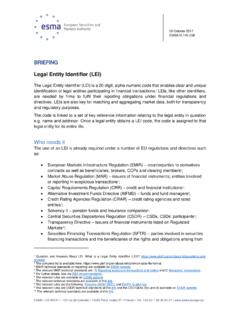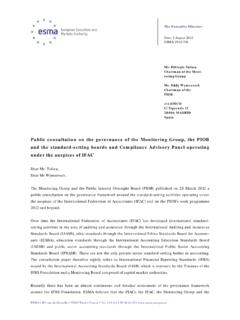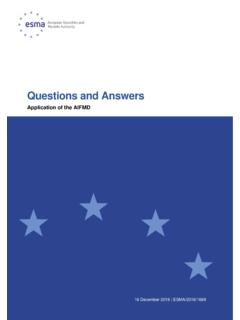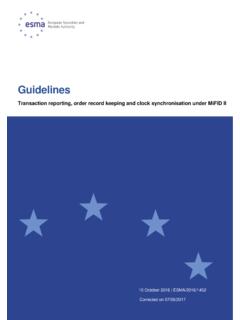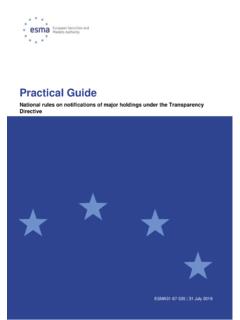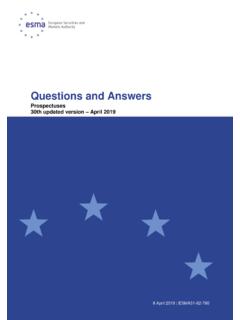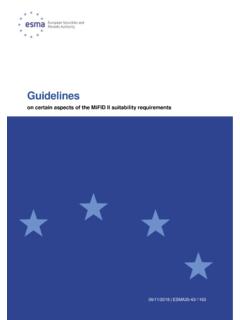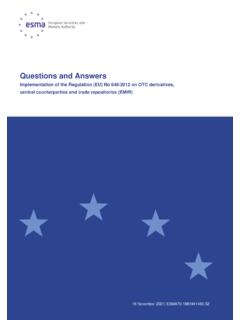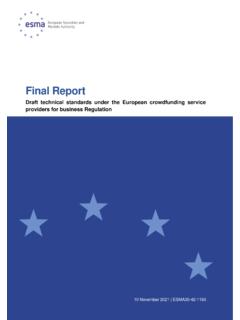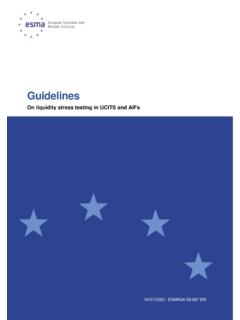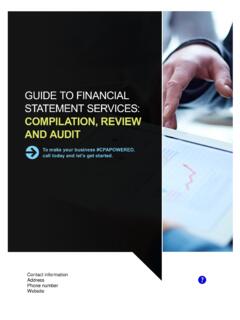Transcription of ESEF Reporting Manual
1 5 August 2022 | ESMA32-60-254rev ESEF Reporting Manual preparation of Annual financial Reports in ESEF format 2 1 Table of Contents I. Introduction .. 4 table of updates ..151 Guidance for issuers ..15 presentation of Annual financial Reports (AFRs) in ESEF and in other formats than ESEF 15 Use of languages ..16 Use of elements that are available in the IFRS Taxonomy but are not included in the ESEF taxonomy ..17 Selection of appropriate elements to mark up disclosures ..18 Anchoring ..19 Use of line items or domain members ..20 Use of positive and negative values (signage).
2 22 Units of measure ..22 Footnotes ..23 Block tagging ..24 2 Guidance for software firms to ensure technical validity ..28 Contexts ..28 Facts ..30 Footnotes ..33 Restrictions on Inline XBRL and other constructs ..34 Other content of Inline XBRL documents ..35 Report packages ..39 Technical validity of reports ..40 3 Technical guidance for issuers and software firms on extension taxonomies and other topics ..41 Extension taxonomy ..41 Extension taxonomy elements ..44 Extension taxonomy anchoring ..46 Extension taxonomy linkbases ..48 Other issues.
3 54 3 4 Guidance for preparers of ESEF reports not subject to tagging obligations ..55 Additional guidance for XHTML stand-alone files ..55 4 I. Introduction [Last updated: July 2022] Background 1. The RTS on ESEF1 specifies that all issuers subject to the requirements contained in the Transparency Directive to make public Annual financial Reports shall prepare annual financial reports in the Extensible Hypertext Markup Language (XHTML) format. Where the issuer prepares IFRS consolidated financial statements, it shall mark up these IFRS consolidated financial statements using the XBRL markup language.
4 The markups shall be embedded in the XHTML document version of the annual financial report using the Inline XBRL format. Purpose 2. This document has been produced by ESMA to assist issuers and software vendors in creating ESEF documents that are compliant with the RTS on ESEF. It provides guidance on common issues that may be encountered when creating ESEF documents and explains how to resolve them. The purpose of this document is to promote a harmonised and consistent approach for the preparation of annual financial reports in the format specified in the RTS on ESEF.
5 This document is issued under Article 29(2) of the ESMA Regulation. 3. The content of this document is aimed at issuers who are required to prepare annual financial reports in ESEF format in accordance with Article 4(7) of the Transparency Directive (TD)2 and the RTS on ESEF, and at software firms developing software used for the preparation of annual financial reports in Inline XBRL. The aim of the guidelines defined in this document is to facilitate the analysis and comparison of the XBRL data contained in Inline XBRL documents by investors and other users. In particular, this document provides guidance on the expected syntax and structure of Inline XBRL documents and issuers XBRL extension taxonomies.
6 This document contains parts that are of a highly technical nature, especially sections and These sections are intended for a technical audience and assume that the reader has a working knowledge of the XBRL , XBRL Dimensions , Inline XBRL and other XBRL specifications3, is familiar with the IFRS Taxonomy and has a basic understanding of XML, Namespaces and XML Schema. 1 Commission Delegated Regulation (EU) 2019/815 of 17 December 2018 supplementing Directive 2004/109/EC of the European Parliament and of the Council with regard to regulatory technical standards on the specification of a single electronic Reporting format 2 Directive 2004/109/EC of the European Parliament and of the Council of 15 December 2004 on the harmonisation of transparency requirements in relation to information about issuers whose securities are admitted to trading on a regulated market and amending Directive 2001/34/EC, as amended by Directive 2013/50/EU 3 5 4.
7 This document is fully aligned with the technical rules and constraints defined in the referenced XBRL technical specifications. Some guidelines may however be more restrictive and precise to address the specifics of the ESEF format. Therefore, this Manual contains some additional validation rules that ESMA recommends for software vendors to implement within their solutions used to produce ESEF inline XBRL reports. In case no specific guidance is provided in this Manual , XBRL specifications must be followed. Furthermore, if any aspect or mechanism covered by the XBRL specifications is not specifically mentioned in this Manual , it does not mean that such aspect or mechanism cannot be used in the ESEF inline XBRL report.
8 5. Each guidance item presented in this document is provided with an indication of criticality. ESMA considers that all items marked as MUST or SHALL are critical to facilitate the consumption and comparability of an ESEF inline XBRL document. Items marked as SHOULD do not generally impact the overall usability of an ESEF file, although this may need to be assessed on a case-by-case basis. 6. The content of this document is not exhaustive and it does not constitute new policy. This document is intended to be continually edited and updated as and when the need to do so arises.
9 7. Stakeholders are encouraged to follow the guidance provided in this document as soon as possible but no later than for financial Reporting periods starting on or after 1 January 2022. Providing feedback on the Reporting Manual 8. Stakeholders wishing to provide feedback or raise questions / concerns with regards to the content of the ESEF Reporting Manual or any of the materials published by ESMA on ESEF are invited to direct such queries to the ESEF support mailbox: Depending on the nature of such queries, ESMA will assess whether it is relevant and/or necessary to provide further clarity or guidance to the public and whether a further revision of the Reporting Manual and/or to other ESEF-related material is deemed appropriate.
10 6 II. Summary table of updates [Last updated: July 2022] Guidance number / section Topic of the Question Last update Glossary July 2022 Guidance presentation of AFRs in the ESEF format July 2022 [new] Guidance presentation of AFRs in other formats than ESEF July 2022 [new] Guidance Language of labels December 2017 Guidance AFRs presented in more than one language July 2022 Guidance Issuers incorporated in third countries that apply IFRS standards or interpretations that are not yet adopted in the EU July 2019 Guidance Use of elements available in the IFRS Taxonomy that were not yet included in the ESEF taxonomy July 2020 Guidance Use of labels to select appropriate elements July 2021 Guidance Markup of disclosures if the ESEF taxonomy only contains an element that is wider in scope or meaning
